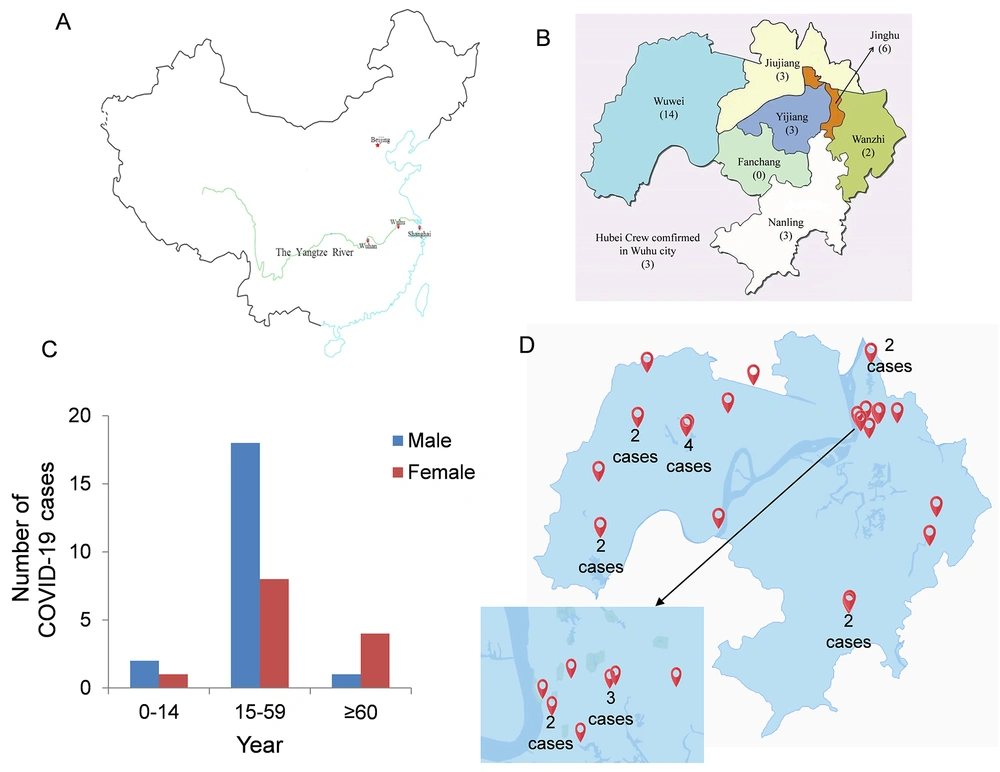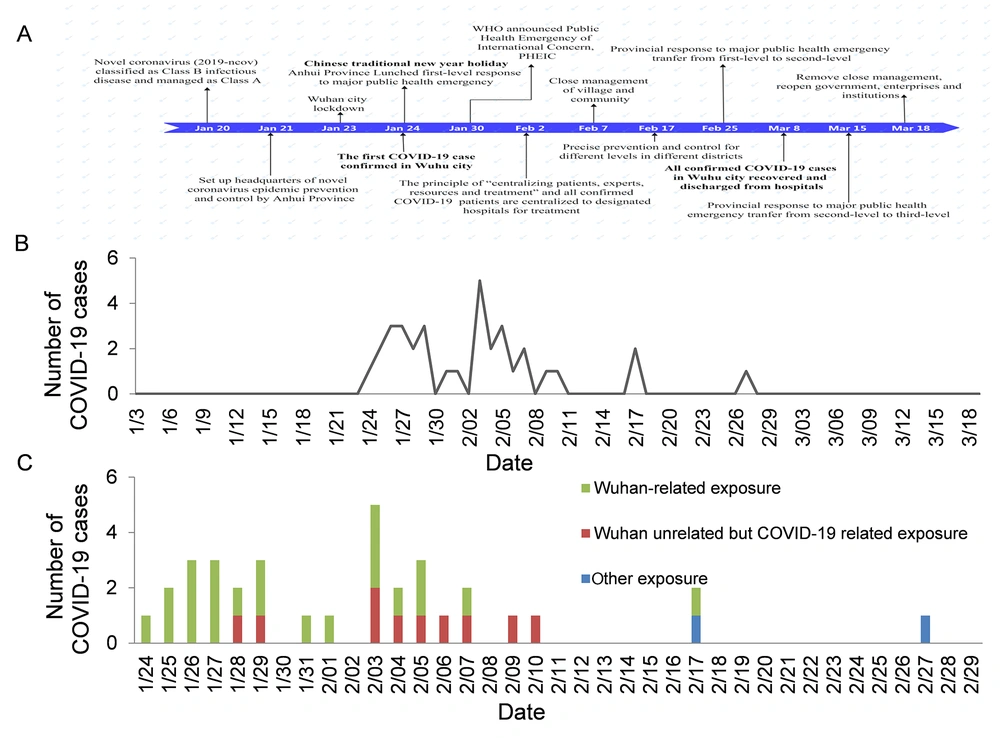1. Background
The COVID-19 pandemic caused by SARS-CoV-2 has lasted for over two years now, and millions of people have died from the disease (1, 2). Much progress has been made in understanding SARS-CoV-2 and developing effective vaccines and antiviral drugs against COVID-19 (3, 4). It is also essential to study the epidemiological characteristics of SARS-CoV-2 infection during early COVID-19 outbreaks in China cities other than Wuhan (5).
2. Objectives
In this report, we studied the first-ever reported outbreak of COVID-19 in Wuhu from January 3 to March 19, 2020. Wuhu is located in the south of Anhui province, with an area of 6,026 square kilometers and about 3.64 million permanent residents across seven districts. Anhui province is adjacent to Hubei province, and Wuhu is about 390 kilometers from Wuhan (Figure 1A and B). Travel between Wuhu and Wuhan can be conveniently achieved within three hours via high-speed rail and ships and boats since both cities are located along the Yangtze River (Figure 1A). Thus, Wuhu represents a unique location to study the earliest events of COVID-19 in China and their relationship to the COVID-19 outbreak in Wuhan.
3. Methods
This study was a descriptive, exploratory analysis of all confirmed COVID-19 cases in Wuhu between January 3 and March 19, 2020. Data collection and analysis were considered part of a continuing public health outbreak investigation and were either exempted from institutional review board (IRB) approval or approved by the IRB of Wannan Medical College. Publicly accessible cumulative numbers of confirmed COVID-19 cases, updated daily by the Health Commission of Wuhu (http://wsjkw.wuhu.gov.cn/xwdt/tzgg/index.html), were collected for preliminary analyses. Population data for each district of Wuhu in 2020 were obtained from the Bureau of Statistics of Wuhu (http://tjj.wuhu.gov.cn/tjxx/tjgb/8282562.html).
4. Results
4.1. Chronological Events of the First COVID-19 Outbreak in Wuhu
After the outbreak of COVID-19 pandemic in Wuhan, the Wuhu government took a series of responses to monitor COVID-19 cases and implement strategies to prevent and control the potential spread of SARS-CoV-2 (Figure 2A). Implementing these policies led to a significant decrease in new COVID-19 cases after February 11, with no new COVID-19 cases reported after February 27, and the last cases were recovered and discharged from the hospitals on March 8 (Figure 2B).
A, timeline of the key events of the COVID-19 outbreaks and public health emergency responses taken in Wuhu; B, daily distribution of the confirmed COVID-19 cases in Wuhu from January 3 to March 19, 2020; C, daily distribution of the confirmed COVID-19 cases with different exposure histories in Wuhu.
4.2. Daily Distribution of Confirmed COVID-19 Cases in Wuhu
Between January 3 and March 19, 2020, the city of Wuhu recorded 34 confirmed COVID-19 cases. The first COVID-19 case was confirmed in January 24, disease incidences initially remained low and sporadic until January 26, followed by a substantial increase until February 3, with cases peaking on February 3 before declining; the last case was reported on February 27 (Figure 2B). The outbreak in Wuhu spanned a period of 34 days, from January 24 to February 27. During the 21 days before January 24 and after February 27, no confirmed COVID-19 cases were reported in Wuhu (Figure 2B).
4.3. Geographic Distribution of Confirmed COVID-19 Cases in Wuhu
Of the 34 COVID-19 cases, including 3 cases representing a Hubei crew from a single cargo ship from Wuhan, the districts of Wuwei, Jinghu, Jiujiang, Yijiang, Nanling, and Wanzhi accounted for 41.18% (14/34), 14.65% (6/34), 8.82% (3/34), 8.82% (3/34), 8.82% (3/34), and 5.88% (2/34), respectively. No confirmed COVID-19 cases were reported in the district of Fanchang (Figure 1B and D). It is noted that Wuwei and Fanchang, the most and least populated districts in Wuhu, had the most and fewest confirmed cases; Jinghu, the fourth most populated district, had the second most confirmed cases.
4.4. Age and Gender Distribution of Confirmed COVID-19 Cases in Wuhu
Of the 34 COVID-19 cases, 21 (21/34, 61.76%) were male, and 13 (13/34, 38.24%) were female (Table 1 and Figure 1C). The gender ratio among the confirmed cases slightly differed from that of the population in Wuhu, which was 51.28% male and 48.72% female. These results suggest that the early strain of SARS-CoV-2 may preferentially infected men over women and are consistent with the current pandemic data showing that women are more resistant to COVID-19 infection than men (5-7). The mean age of COVID-19 cases was 43.80 ± 15.65 years, with the youngest case aged 4 years old and the oldest case aged 80 years old (Table 1). The age distribution among COVID-19 cases was slightly different from that of the population of Wuhu (Figure 1C). These observations suggest that the early strain of SARS-CoV-2 may preferentially infected individuals of 15 - 59 years old but not the elderly (i.e., age > 60 years) or the young groups (i.e., age < 14 years). These results differ from the current pandemic data on age distribution (7).
| Characteristic | Cases (n = 34) |
|---|---|
| Age (y) | |
| Mean ± SD | 43.80 ± 15.65 |
| Range | 4 - 80 |
| Age group (y) | |
| 0 - 14 | 3 |
| 15 - 59 | 26 |
| ≥ 60 | 5 |
| Sex | |
| Male | 21 |
| Female | 13 |
| Clinical outcome | |
| Remained in hospital | 0 |
| Discharged | 34 |
| Died | 0 |
| Epidemiologic risk category | |
| Wuhan-related exposure | 22 |
| Wuhan-unrelated but COVID-19-related exposure | 10 |
| Other exposure | 2 |
Clinical Characteristics and Epidemiologic Risk Factors Among Confirmed COVID-19 Cases in the City of Wuhu as of March 19, 2020
4.5. Links Between Confirmed COVID-19 Cases in Wuhu and the Outbreak in Wuhan
To understand the origin of these confirmed COVID-19 cases in Wuhu, we categorized all 34 cases into three groups based on their potential links to the outbreak in Wuhan (Table 1 and Figure 2C). Twenty-two cases had Wuhan-related exposure (22/34, 64.71%); 10 cases did not have Wuhan-related exposure but had close contact with these 22 confirmed COVID-19 cases in Wuhu (10/34, 29.41%); and only 2 cases had neither Wuhan-related exposure nor close contact with confirmed COVID-19 cases.
4.6. Cluster Case Analysis in Wuhu
A total of 8 clustered outbreaks occurred with 20 cases, accounting for 58.82% (20/34) of the total 34 cases (Table 2 and Figure 1D). The district where the most outbreaks occurred was Wuwei (3 outbreaks). The shortest interval between the first and last cases was 0 days, and the longest interval between the first and the last cases was 14 days (Table 2). The cases with an interval of 0 days suggest that those cases could have been infected simultaneously. The cases with an interval of 14 days suggest that they could have been infected subsequently.
| No | The Confirmed Time Interval Between the First Case and the Last Case (d) | The Number of Cases | Relationship | Outbreak Areas |
|---|---|---|---|---|
| 1 | January 26 to February 5; 10 | 2 | Son (WH005) and mother (WH025) | Wuwei |
| 2 | January 26 to February 5; 10 | 4 | Mother (WH004), grandfather (WH013), daughter (WH020) and neighbor (WH026) | Wuwei |
| 3 | February 6 to February 10; 4 | 2 | Son (WH027) and mother (WH031) | Wuwei |
| 4 | February 1 to February 5; 4 | 3 | Neighbor (WH016, WH022, and WH024) | Jinghu |
| 5 | February 3 to February 7; 4 | 2 | Mother (WH018) and son (WH029) | Yijiang |
| 6 | February 7 to February 9; 2 | 2 | Husband (WH028) and wife (WH030) | Jiujiang |
| 7 | February 3 to February 17; 14 | 2 | Father (WH021) and son (WH032) | Nanling |
| 8 | February 27; 0 | 3 | Hubei crew working in the same cargo ship (WH007, WH008, and WH009) | Wuhu |
Characteristics of the COVID-19 Cluster Outbreaks in Wuhu
5. Discussion
The emergence of novel variants of concern (VOCs) of SARS-CoV-2, such as the alpha, beta, gamma, delta, and omicron variants, has presented significant challenges to the control and prevention of SARS-CoV-2 infections, as these VOCs exhibit the ability to escape antiviral immunity induced by vaccination and have caused breakthrough infections (8, 9). Understanding the events at the beginning of the COVID-19 pandemic is critical to combat SARS-COV-2. This report focuses on a descriptive epidemiological analysis of the early outbreaks of COVID-19 in the city of Wuhu, between January and March 2020. Our studies suggest that confirmed COVID-19 cases in Wuhu could be traced back to the outbreak in Wuhan. The majority (i.e., 32 cases) of 34 confirmed COVID-19 cases in Wuhu were directly or indirectly linked to COVID-19 outbreaks in Wuhan epidemiologically. Twenty-two cases had recently resided in or traveled to Wuhan or had close contact with a Wuhan resident or visitor; 10 cases were in close contact with those 22 confirmed cases, and only 2 had no epidemiological link to the COVID-19 outbreak in Wuhan (Table 1). Hence, the COVID-19 outbreak in Wuhan represents the source and origin of the COVID-19 cases in Wuhu.
Our analyses suggest that the COVID-19-affected areas were unevenly distributed in Wuhu (Figure 1D). Wuwei, the most populated district in Wuhu, had the most cases (14 cases). The Wuwei district has a large population of migrant workers, who had high human mobility with Wuhan/Hubei during the Chinese New Year holiday. Jinghu, the fourth most populated district, had the second most cases (6 cases). This is possible because Jinghu is Wuhu's political and commercial center and is closely connected to Wuhan by a three-hour high-speed rail trip. Although strict control measures were implemented between villages and communities, there were still many close contacts with imported cases or returnees from Wuhan/Hubei, which were not fully controlled, thus leading to a COVID-19 outbreak in Wuhu (10-12).
Our analyses also suggest that COVID-19 epidemic curves reflected a mixed outbreak pattern in Wuhu city. Cases in the Wuhan-related exposure group (22/34, 64.71%) dominated during the beginning of Wuhu's COVID-19 epidemic from January 24 to February 1, 2020, with most cases being imported from or directly linked to Wuhan/Hubei. As a major labor export province in China, Anhui province has close transport connections and human mobility flow with Wuhan during the Chinese New Year holiday season (10, 12, 13). From February 3, 2020, cases belonging to the "Wuhan-unrelated but COVID-19-related exposure" group (10/34, 29.41%) increased, suggesting that SARS-CoV-2 was then on transmission from person to person in the community in Wuhu (Figure 2C).
Our studies may have several limitations. For example, despite the timely and urgent implementation of public health responses, records of COVID-19 cases may be missing or incorrect. Moreover, some clinical and epidemiologic risk factor data might be incomplete (10, 14). Due to the limited number (i.e., 34 cases) of confirmed COVID-19 cases, we could not conclusively determine if the outbreak in Wuhu during the initial pandemic period had a lower mortality rate than the global mortality rates later in the pandemic. However, no mortality was reported in this study (Table 1) (1, 5).


